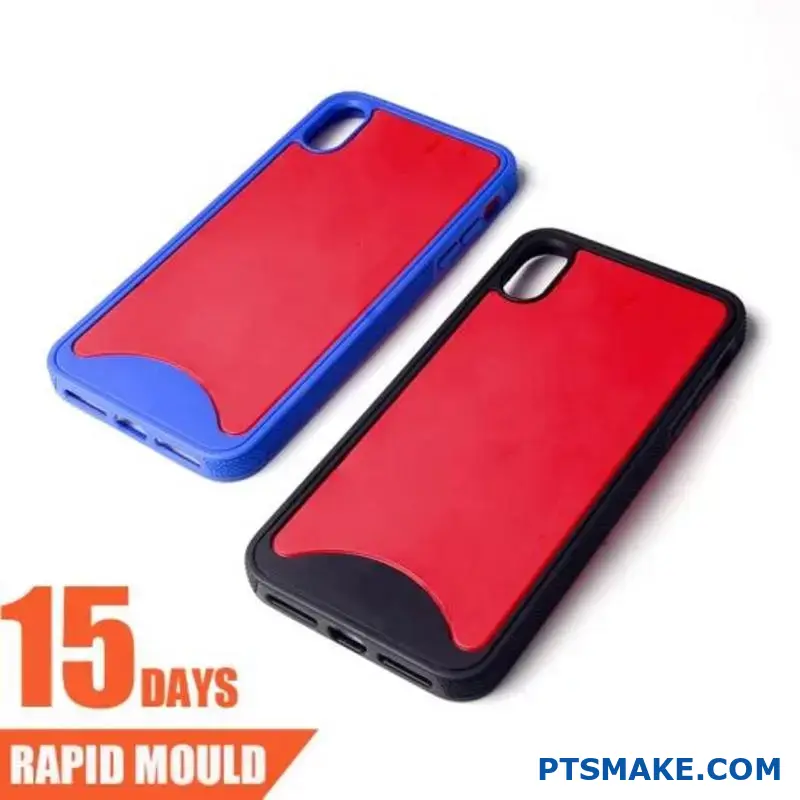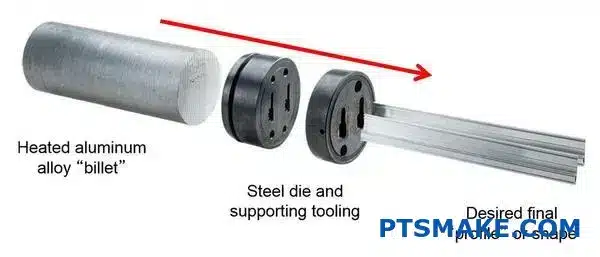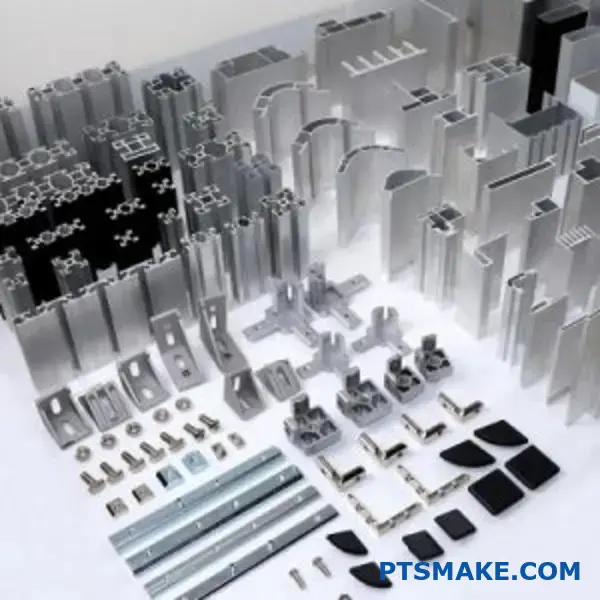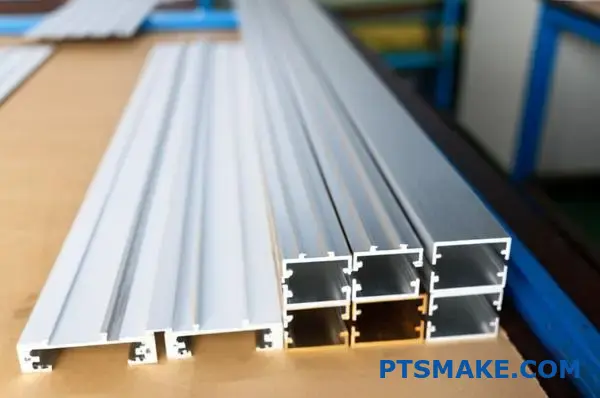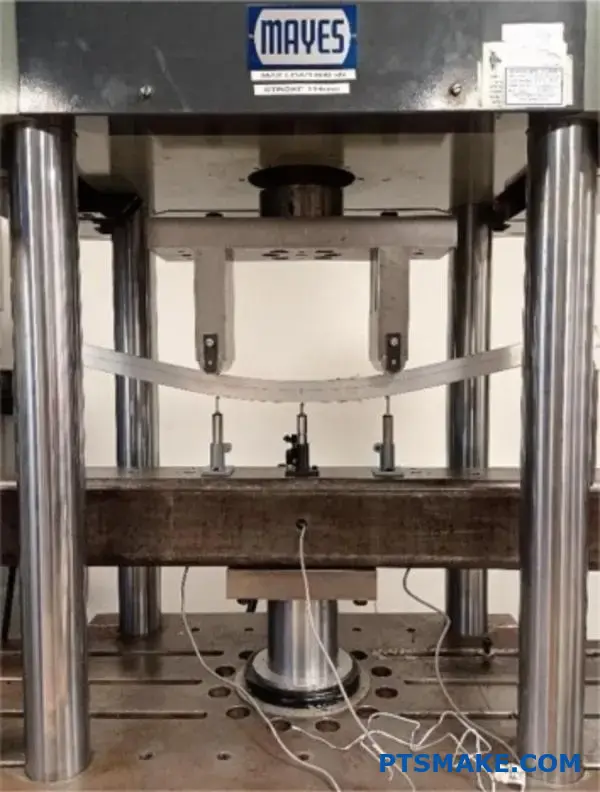Medical device manufacturing faces stringent regulatory demands and zero tolerance for errors. Unlike other industries, even minor defects in medical components can lead to life-threatening situations, putting enormous pressure on manufacturers to achieve perfect results every time.
CNC machining for medical purposes differs primarily in its exceptional precision requirements, biocompatible material selection, strict regulatory compliance, and comprehensive documentation protocols that exceed standard manufacturing practices in other industries.
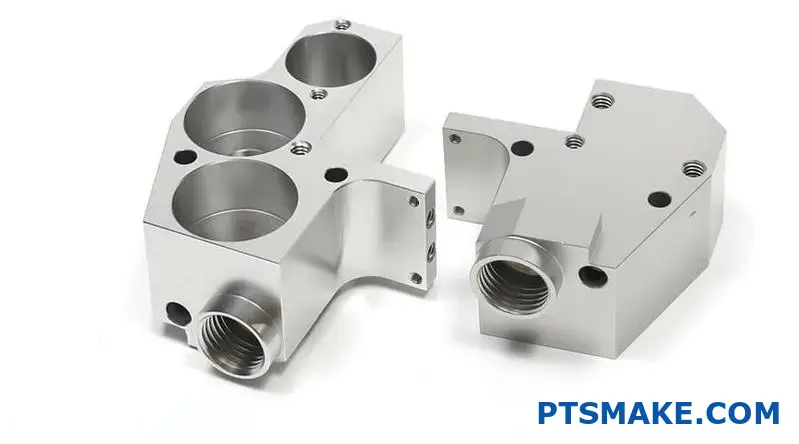
I’ve seen the dramatic differences in medical CNC machining firsthand at PTSMAKE. The stakes are simply higher when you’re creating parts that go into surgical instruments or implantable devices. If you’re considering medical device manufacturing, understanding these unique challenges is crucial. Let me walk you through the key differences that make medical CNC machining a specialized field with its own set of rules and requirements.
Why Precision Is Important In Medical CNC Machining?
Have you ever considered what happens when a surgical implant doesn’t fit perfectly? Or when medical device components have microscopic flaws? The consequences can be catastrophic—patient harm, device failure, or even life-threatening situations during critical procedures.
Precision in medical CNC machining is absolutely crucial because it directly impacts patient safety and treatment outcomes. When manufacturing medical devices, even deviations of a few micrometers can mean the difference between a successful procedure and a medical emergency. This level of accuracy ensures devices function exactly as designed.
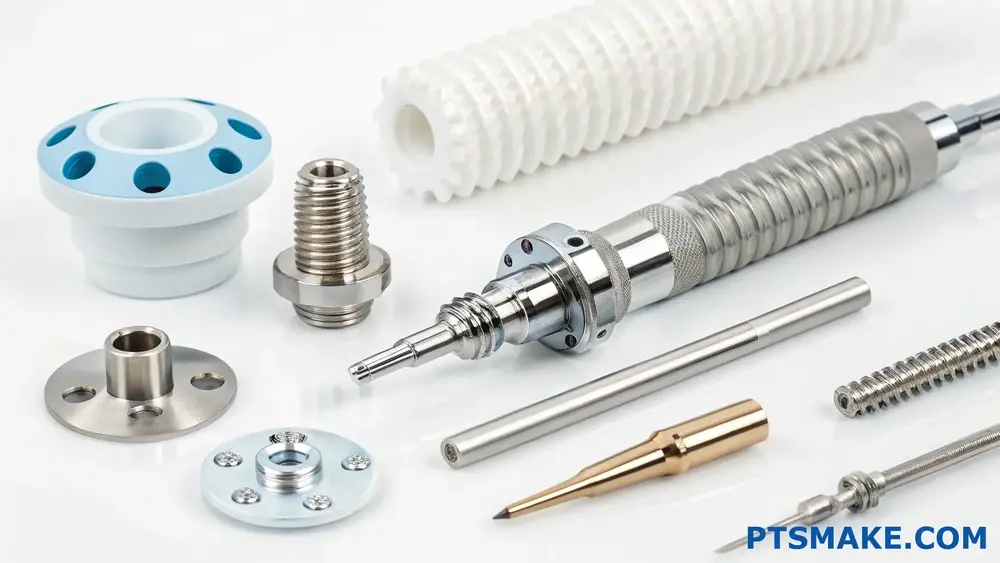
The Critical Role of Precision in Medical Devices
In my experience working with medical device manufacturers, precision isn’t just a technical specification—it’s a fundamental requirement that directly impacts human lives. Medical CNC machining must achieve tolerances that are often much stricter than those in other industries.
Medical devices require extraordinary precision for several reasons:
- Patient Safety: Implants, surgical instruments, and diagnostic equipment must function flawlessly in critical situations.
- Regulatory Compliance: Medical devices must meet stringent FDA and other international regulatory standards.
- Functionality: Complex medical devices often contain intricate moving parts that must work together perfectly.
- Biocompatibility: Precise surface finishes are essential for how materials interact with human tissue.
The Consequences of Imprecision in Medical Manufacturing
When precision fails in medical component manufacturing, the consequences can be severe. Let me share what can happen when tolerances aren’t met:
Clinical Implications
Poor precision in medical parts can lead to:
- Surgical instrument failure during procedures
- Implant loosening or rejection
- Diagnostic equipment providing inaccurate readings
- Drug delivery systems administering incorrect dosages
I’ve seen cases where seemingly minor machining errors resulted in complete device recalls, costing manufacturers millions and potentially putting patients at risk.
Financial Impact
The financial consequences of precision failures are substantial:
| Consequence | Potential Cost Impact |
|---|---|
| Product recalls | $2-10 million per incident |
| Regulatory penalties | Up to $500,000+ per violation |
| Litigation | Potentially unlimited liability |
| Brand damage | Long-term market share loss |
Key Precision Requirements in Medical CNC Machining
Medical CNC machining typically demands the following precision specifications:
Dimensional Tolerances
For critical medical components, tolerances as tight as ±0.0001 inches (2.54 micrometers) are common. At PTSMAKE, we regularly achieve these ultraprecision tolerances1 for components like:
- Orthopedic implant interfaces
- Heart valve components
- Surgical robot articulation joints
- Micro-fluidic diagnostic devices
Surface Finish Requirements
Surface quality is equally important in medical applications:
- Implants often require Ra values of 0.2-0.4 μm for proper tissue integration
- Fluid pathway components need mirror-like finishes (Ra < 0.1 μm) to prevent flow disruption
- Bearing surfaces in artificial joints require exceptional smoothness to minimize wear
Material Considerations
Precision machining becomes even more challenging when working with medical-grade materials:
- Titanium alloys: Notorious for tool wear and heat generation
- Medical-grade stainless steel: Can work-harden during machining
- PEEK and other medical polymers: Require specific cutting parameters to maintain dimensional stability
Advanced Technologies Enabling Medical Machining Precision
To achieve the necessary precision for medical components, manufacturers must leverage several cutting-edge technologies:
5-Axis Simultaneous Machining
This technology allows for complex geometries to be machined in a single setup, eliminating positional errors that occur when parts are repositioned. For spinal implants with complex organic shapes, this capability is invaluable.
In-Process Measurement Systems
Real-time monitoring using laser measurement, touch probes, and vision systems ensures parts meet specifications while they’re being machined, not just after completion. This prevents wasted materials and time on out-of-spec components.
Temperature-Controlled Environments
Many high-precision medical components require machining in temperature-controlled environments (typically ±1°C) to prevent thermal expansion from affecting dimensional accuracy.
Verification Processes for Medical Machining
The validation of precision is as important as achieving it. Medical component manufacturers implement rigorous inspection protocols:
- Coordinate Measuring Machines (CMMs) with accuracy to 0.0001"
- Optical comparators for profile verification
- Surface roughness testers for finish validation
- CT scanning for internal feature inspection
At PTSMAKE, we’ve implemented a comprehensive inspection process for all medical components, ensuring 100% verification of critical dimensions rather than relying on statistical sampling methods.
What Materials Are Commonly Used In Medical CNC Machining?
Have you ever wondered why some medical devices feel so smooth and precise in your hand, while others seem cheaply made and unreliable? The difference often comes down to material selection – the critical decision that determines whether a medical device succeeds or fails in its life-saving mission.
Medical CNC machining commonly uses titanium alloys, stainless steel, aluminum, PEEK, Delrin (POM), PTFE, medical-grade silicone, and various biocompatible plastics. These materials are selected for their biocompatibility, sterilization resistance, mechanical properties, and compliance with FDA and ISO regulations.
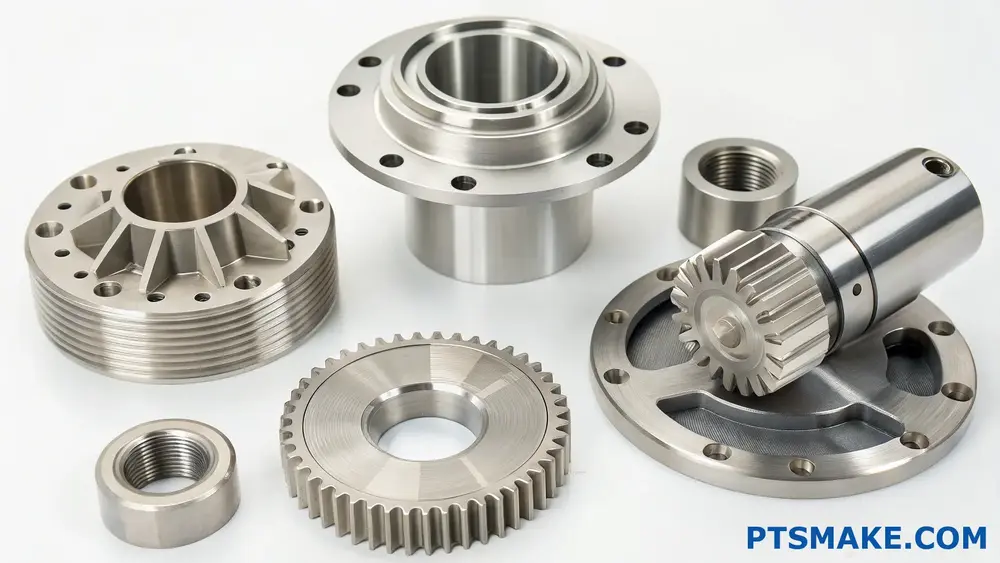
Essential Properties of Medical Machining Materials
When selecting materials for medical CNC machining projects, several critical properties must be considered. In my work at PTSMAKE, I’ve found that understanding these fundamental requirements helps engineers make better choices for their specific applications.
Biocompatibility: The First Priority
Biocompatibility is non-negotiable for materials used in medical devices that contact the human body. This property ensures the material won’t cause adverse reactions, inflammation, or rejection when exposed to living tissue or bodily fluids. Different applications require different levels of biocompatibility:
- Short-term contact devices (like surgical instruments) need basic biocompatibility
- Implantable devices require long-term biocompatibility testing
- Blood-contacting devices need hemocompatibility testing
The FDA categorizes biocompatibility testing requirements based on the duration and type of body contact, making this a regulated aspect of medical device design.
Sterilization Resistance
Medical components must withstand repeated sterilization without degradation. Common sterilization methods include:
| Sterilization Method | Temperature | Advantages | Suitable Materials |
|---|---|---|---|
| Autoclave (Steam) | 121-134°C | Effective, economical | Stainless steel, titanium, some polymers |
| Ethylene Oxide | 30-60°C | Low temperature | Most metals, temperature-sensitive polymers |
| Gamma Radiation | Ambient | No heat, highly effective | Metals, most polymers (except PTFE) |
| Electron Beam | Ambient | Fast processing | Similar to gamma compatible materials |
Materials that maintain dimensional stability and mechanical properties after multiple sterilization cycles are highly valued in the medical industry.
Mechanical Properties
The mechanical demands on medical components vary widely by application. For orthopedic implants, high fatigue resistance and tensile strength are crucial. For surgical instruments, hardness and wear resistance become primary concerns. Some key mechanical properties include:
- Strength-to-weight ratio: Particularly important for portable devices
- Wear resistance: Critical for components with moving parts
- Fatigue resistance: Essential for implants and repeatedly used instruments
- Elasticity/rigidity: Must match the specific application requirements
Regulatory Compliance
All materials used in medical devices must comply with relevant regulations. At PTSMAKE, we ensure that materials meet USP Class VI2 standards or have FDA master files. International standards like ISO 10993 for biocompatibility evaluation are also essential benchmarks for material selection.
Most Common Materials in Medical CNC Machining
Based on projects I’ve overseen, these materials represent the majority of what’s used in medical device manufacturing:
Titanium and Titanium Alloys
Titanium, particularly Ti-6Al-4V (Grade 5), is the gold standard for implantable devices due to its:
- Exceptional biocompatibility
- Strength-to-weight ratio comparable to steel at 45% lighter weight
- Corrosion resistance superior to stainless steel
- MRI compatibility
- Osseointegration properties (bone can grow directly onto it)
The main limitation is cost, as titanium machining requires specialized expertise and tooling, which we’ve developed extensively at PTSMAKE for our medical clients.
Medical-Grade Stainless Steel
The 300 series stainless steels (particularly 316L) are workhorses in medical device manufacturing:
- Excellent corrosion resistance
- Good strength and durability
- Cost-effective compared to titanium
- Easy to machine and finish to high standards
316L is favored for surgical instruments, laboratory equipment, and temporary implants. Its high chromium content creates a passive oxide layer that prevents corrosion.
PEEK (Polyetheretherketone)
This high-performance thermoplastic has revolutionized certain medical applications:
- Biocompatibility comparable to UHMWPE
- Excellent mechanical and chemical resistance
- X-ray transparency (valuable for radiographic procedures)
- Modulus similar to human bone, reducing stress shielding
- Sterilization compatibility with all standard methods
PEEK is increasingly used for spinal implants, dental abutments, and orthopedic applications where its bone-like mechanical properties offer significant advantages.
Aluminum Alloys
For non-implantable medical devices and equipment housings, aluminum alloys (particularly 6061-T6) offer:
- Lightweight construction
- Good machinability and surface finish capabilities
- Excellent thermal conductivity
- Cost-effectiveness
- Corrosion resistance when properly anodized
Aluminum components are common in diagnostic equipment, surgical tool handles, and external medical device housings.
The success of any medical device ultimately depends on choosing the right material for its specific application. Each material offers a unique profile of properties that must be carefully matched to the device requirements, regulatory standards, and manufacturing constraints.
Quality Systems and Documentation Requirements for FDA-Compliant Medical CNC Machining?
Have you ever received FDA warnings about your medical device components due to insufficient documentation? Or struggled with maintaining consistent quality across production runs while meeting stringent regulatory requirements? These challenges can quickly escalate from minor paperwork issues to serious compliance violations.
Medical CNC machining achieves FDA compliance through robust quality management systems, comprehensive documentation, material traceability, and validated processes. The backbone of compliance is establishing documented procedures that ensure every component meets predefined specifications and regulatory standards throughout its lifecycle.
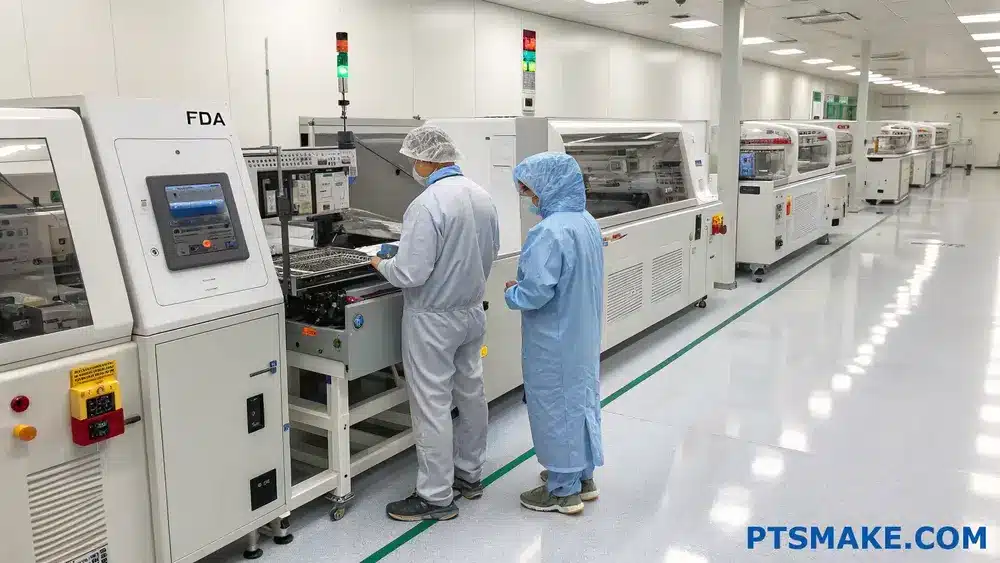
Implementing Effective Quality Management Systems for Medical CNC Machining
At the core of FDA compliance lies a well-structured Quality Management System (QMS). For medical CNC machining, this system serves as the foundation that ensures all processes consistently meet regulatory requirements. The QMS must be comprehensive yet practical enough to implement in daily operations.
The FDA explicitly requires medical device manufacturers and their suppliers to establish and maintain quality systems as outlined in 21 CFR Part 820. In my experience working with medical device manufacturers, companies that invest in robust QMS structures experience fewer compliance issues during FDA inspections.
A properly implemented QMS for medical CNC machining should include:
Process Validation Protocols
Process validation is essential for demonstrating that your CNC machining processes consistently produce components that meet predetermined specifications. This isn’t just a one-time activity but requires:
- Installation Qualification (IQ): Verifying that equipment is properly installed
- Operational Qualification (OQ): Confirming that equipment operates as intended
- Performance Qualification (PQ): Ensuring consistent performance under actual production conditions
When implementing process validation, I recommend establishing clear acceptance criteria before testing begins. This approach prevents moving goalposts during validation and ensures objective assessment.
Document Control Systems
Document control represents one of the most critical aspects of FDA compliance. The cGMP regulations3 require that all documents related to production, testing, and quality assurance be properly controlled, with revisions tracked and approvals documented.
An effective document control system should manage:
- Design specifications
- Manufacturing procedures
- Inspection protocols
- Training records
- Validation documentation
- Nonconformance reports
At PTSMAKE, we implement electronic document management systems that create audit trails for all changes, ensuring nothing falls through the cracks. This digital approach has significantly improved our compliance posture while reducing administrative burden.
Training Requirements and Records
The FDA expects all personnel involved in manufacturing medical components to be adequately trained. This includes machine operators, quality inspectors, and supervisory staff. Training records must demonstrate that each individual is qualified to perform their specific tasks.
Training documentation should include:
- Training content and materials
- Assessment methods
- Competency evaluations
- Periodic retraining schedules
- Training effectiveness reviews
Material Traceability and Control Systems
Medical CNC machining requires complete traceability of materials from receipt through manufacturing to final delivery. This creates a continuous chain of custody that allows for rapid response should safety issues arise.
Lot Control and Serialization
Effective lot control enables the tracking of raw materials, components, and finished products through the manufacturing process. When properly implemented, this system allows for:
| Traceability Element | Purpose | FDA Requirement |
|---|---|---|
| Material certificates | Verify material composition | Required for critical components |
| Lot numbering | Track materials through production | Required for all medical devices |
| Process records | Document manufacturing conditions | Required with retention periods |
| Testing data | Confirm specification compliance | Required with statistical analysis |
Serialization takes traceability to the component level, which is particularly important for implantable devices or critical components. Modern CNC systems can incorporate serialization directly into the machining process, eliminating human error.
Supplier Quality Management
The FDA holds you responsible for your suppliers’ quality, making supplier management crucial. For medical CNC machining, this means:
- Qualifying suppliers through rigorous assessment
- Establishing quality agreements that define responsibilities
- Conducting periodic audits of critical suppliers
- Implementing incoming inspection protocols
- Maintaining supplier performance metrics
When sourcing CNC machining services for medical components, I always verify that suppliers maintain appropriate material certificates and can provide complete traceability documentation.
Nonconformance Management and CAPA Systems
No manufacturing process is perfect, but how you handle deviations separates compliant operations from those at risk. Effective nonconformance management includes:
- Clear definitions of nonconforming conditions
- Documented decision-making processes for disposition
- Segregation protocols for nonconforming materials
- Risk assessment methodologies
- Notification procedures for serious deviations
The Corrective and Preventive Action (CAPA) system builds on nonconformance management by addressing root causes and preventing recurrence. An effective CAPA system should be:
- Risk-based in its approach
- Properly resourced with qualified personnel
- Timely in implementation
- Measured for effectiveness
- Documented thoroughly
Through implementing robust CAPA systems, we’ve helped our medical device partners maintain consistent FDA compliance while continuously improving their product quality.
Quality Management Systems and Standards for Medical CNC Machining
Have you ever questioned whether your medical device parts manufacturer truly meets the rigorous industry standards? Or worried that overlooking a single certification might lead to regulatory issues, costly recalls, or even patient safety concerns?
The cornerstone of medical CNC machining compliance is ISO 13485 certification, which demonstrates a supplier’s ability to consistently meet medical device regulatory requirements. Additional essential certifications include FDA registration, GMP compliance, and specific standards like ISO 14971 for risk management and ISO 9001 for quality management.

Understanding the ISO 13485 Framework
ISO 13485 is the gold standard for medical device manufacturing quality management systems. Unlike its cousin ISO 9001, ISO 13485 has been developed specifically for medical device manufacturing with additional requirements that address the unique needs of the healthcare industry.
During my consulting work with medical device startups, I’ve seen how ISO 13485 certification provides a structured approach to quality management throughout the entire product lifecycle. The standard requires:
- Comprehensive documentation of all processes
- Risk management integration throughout the quality system
- Strict validation procedures for manufacturing processes
- Enhanced traceability requirements for medical components
- Specialized control of contamination and cleanliness
When selecting a CNC machining partner for medical components, verification of their ISO 13485 certification should be your first step. This isn’t just about checking a box—it’s about ensuring your supplier has implemented a robust quality management system specifically designed for medical device manufacturing.
FDA Registration and Compliance Requirements
For suppliers serving the U.S. medical market, FDA registration is non-negotiable. The FDA maintains oversight of medical device manufacturers through its Quality System Regulation (QSR), also known as 21 CFR Part 820.
While ISO 13485 and FDA QSR share many similarities, they aren’t identical. The FDA requirements include:
- Registration of manufacturing facilities
- Listing of medical devices being produced
- Implementation of a compliant quality system
- Medical Device Reporting (MDR) procedures
- Potential inspection by FDA officials
Differences Between FDA QSR and ISO 13485
| Aspect | FDA QSR (21 CFR Part 820) | ISO 13485:2016 |
|---|---|---|
| Focus | U.S. regulatory compliance | International standard |
| Design controls | More prescriptive requirements | Performance-based approach |
| Documentation | Specific record-keeping mandates | Flexible documentation model |
| Complaint handling | Detailed MDR requirements | General complaint processes |
| Inspections | Subject to FDA audits | Third-party certification |
At PTSMAKE, we maintain both ISO 13485 certification and FDA registration, allowing us to serve medical device clients globally while ensuring compliance with U.S.-specific requirements.
Good Manufacturing Practices (GMP) Compliance
GMP compliance is another critical certification for medical CNC machining suppliers. These practices ensure that products are consistently produced according to quality standards appropriate for their intended use.
The core principles of GMP include:
- Clearly defined manufacturing processes with proven capability
- Validated critical manufacturing processes
- Clear instructions and procedures for each production step
- Properly trained operators following defined procedures
- Records proving correct steps were taken during manufacturing
- Systems for recalling any batch of product
- Complaint investigation procedures
GMP requirements can vary by region, with the EU referring to them as "Good Manufacturing Practice" and the U.S. often incorporating them into the Quality System Regulation. When evaluating a potential supplier, ask about their GMP compliance4 and how they’ve integrated these practices into their overall quality system.
Additional Certifications for Enhanced Credibility
Beyond the fundamental certifications, several supplementary standards can demonstrate a supplier’s commitment to excellence in medical manufacturing:
ISO 14971: Risk Management
This standard provides a framework for managing risks associated with medical devices. A supplier following ISO 14971 will:
- Identify hazards related to medical devices
- Estimate and evaluate risks
- Control risks
- Monitor effectiveness of controls
ISO 9001: Quality Management
While less specific than ISO 13485, ISO 9001 certification demonstrates a baseline quality management system. Many medical CNC machining suppliers maintain both certifications.
ISO 14001: Environmental Management
This certification demonstrates environmental responsibility, which is increasingly important for many medical device companies pursuing sustainable supply chains.
Material Certifications
For critical medical applications, suppliers should provide material certifications documenting the composition and properties of raw materials used in manufacturing. These typically include:
- Chemical composition analysis
- Mechanical property testing results
- Heat treatment verification
- Traceability information
Industry-Specific Standards for Specialized Applications
Depending on the specific medical application, additional certifications might be necessary:
- ASTM F138 for surgical implant materials
- USP Class VI for biocompatibility testing
- ISO 10993 for biological evaluation of medical devices
- REACH and RoHS compliance for environmental regulations
At PTSMAKE, we regularly work with medical device companies with varying regulatory requirements. Our experience has taught us that early discussion of certification requirements is essential to avoid compliance issues later in the product development cycle.
Validation and Verification Capabilities
Beyond formal certifications, medical CNC machining suppliers should demonstrate robust validation and verification capabilities, including:
- Process validation protocols
- Equipment qualification (IQ/OQ/PQ)
- Statistical process control
- Inspection capabilities (CMM, vision systems, etc.)
- Non-destructive testing methods
- Clean room manufacturing capabilities (when required)
These capabilities ensure that the manufacturing processes are capable of consistently producing parts that meet specifications and regulatory requirements.
How Does Medical CNC Machining Handle Complex Geometries And Tight Tolerances?
Have you ever examined a medical implant and wondered how its intricate features were crafted with such precision? Or perhaps you’ve held a surgical instrument, marveling at how perfectly each curve and edge fits its purpose? The complexity behind creating these life-saving devices often goes unnoticed by many.
Medical CNC machining handles complex geometries and tight tolerances through advanced multi-axis machining centers, specialized micro-machining techniques, sophisticated CAD/CAM software integration, and rigorous quality control systems that maintain precision down to micron levels throughout the manufacturing process.
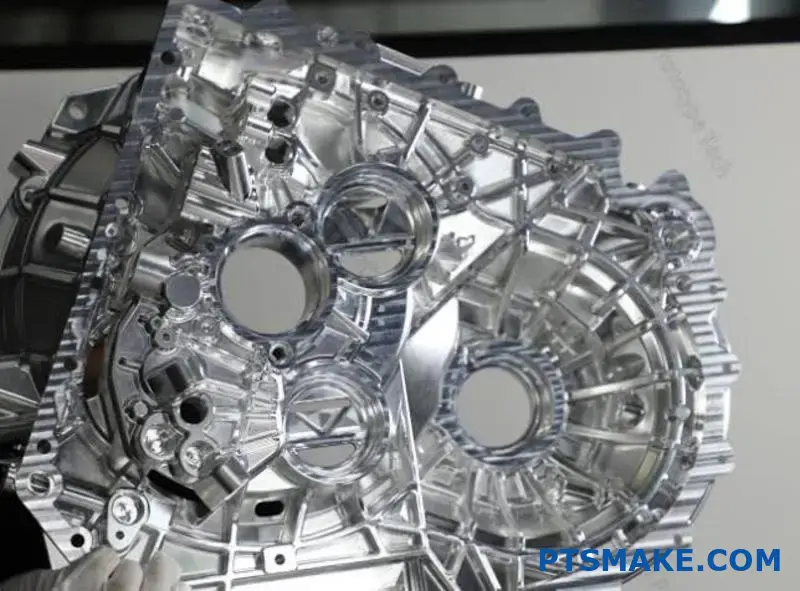
The Role of Advanced Machine Technology in Medical Component Manufacturing
Modern medical device manufacturing requires precision that would have been impossible just decades ago. At PTSMAKE, I’ve implemented various advanced CNC technologies specifically optimized for the medical sector. Five-axis and multi-axis CNC machine centers form the backbone of our capabilities when tackling complex medical geometries.
The key advantage of multi-axis machining is the ability to approach a workpiece from virtually any angle without repositioning. This capability is crucial when manufacturing components like orthopedic implants with organic contours or intricate surgical tools with compound angles. By maintaining the workpiece in a single setup, we significantly reduce the dimensional stack-up errors5 that occur when parts are repeatedly repositioned.
Micro-Machining Capabilities for Medical Components
Medical devices continue to trend toward miniaturization, requiring machining capabilities at increasingly smaller scales. Modern medical micro-machining techniques allow us to:
- Create features as small as 0.005 mm
- Maintain tolerances of ±0.005 mm consistently
- Produce surface finishes below 0.2 Ra microns
- Machine thin walls down to 0.1 mm thickness
These capabilities become essential when manufacturing minimally invasive surgical instruments, diagnostic equipment components, and implantable devices that must interact with delicate human tissues.
Software Integration for Complex Medical Geometries
The precision journey begins long before metal meets cutting tool. Advanced CAD/CAM software integration has revolutionized how we approach complex medical parts manufacturing.
CAD/CAM Workflow for Medical Components
Our medical machining workflow typically follows this process:
- Import anatomical data (often from CT or MRI scans)
- Convert scan data to optimized CAD models
- Apply design for manufacturability principles
- Generate toolpaths with specialized CAM software
- Simulate machining processes to identify potential issues
- Post-process code for specific machine controllers
This integrated approach allows for the creation of patient-specific implants and devices that perfectly match anatomical requirements while remaining manufacturable.
Material Considerations in Medical CNC Machining
Material selection dramatically impacts how we approach complex medical component manufacturing:
| Material Type | Advantages | Machining Challenges | Common Applications |
|---|---|---|---|
| Titanium Alloys | Biocompatible, high strength-to-weight ratio | Work hardening, heat build-up | Implants, surgical instruments |
| Medical-Grade Stainless Steel | Corrosion resistance, durability | Abrasive, tool wear concerns | Surgical tools, equipment frames |
| PEEK and Medical Polymers | Radiolucent, bone-like mechanical properties | Chip control, heat sensitivity | Spinal implants, diagnostic equipment |
| Cobalt Chrome | Wear resistance, biocompatibility | Extremely hard, specialized tooling required | Joint replacements, dental implants |
When machining these materials, we must carefully consider cutting strategies, tool selection, and cooling approaches. For instance, titanium’s poor thermal conductivity requires specialized cutting techniques to prevent heat damage to both the part and cutting tools.
Quality Control Methodologies for Tight Tolerances
Maintaining tight tolerances in medical components isn’t just about precise machining—it requires comprehensive quality systems throughout the process.
At PTSMAKE, our quality control methodology incorporates:
In-Process Measurement Systems
Rather than waiting until post-production inspection, we integrate measurement directly into the machining process. Probing systems on our CNC machines verify critical dimensions during machining, allowing for real-time adjustments if necessary. This approach is particularly valuable for complex medical components where rework may be impossible.
Advanced Metrology Equipment
For final verification, we utilize:
- Coordinate measuring machines (CMMs) with accuracy to 0.001 mm
- Optical measurement systems for non-contact inspection
- Surface roughness analyzers that quantify finish characteristics
- CT scanning for internal geometries of complex components
This multi-faceted approach ensures that every medical component meets the strict requirements for form, fit, and function.
Balancing Precision with Production Efficiency
One of the greatest challenges in medical CNC machining is maintaining tight tolerances while achieving reasonable production efficiency. I’ve found that implementing these strategies helps balance these competing demands:
- Optimized cutting parameters based on material-specific databases
- Tool monitoring systems that detect wear before tolerance issues occur
- Thermal stabilization of both machines and materials
- Strategic batch sizing to maximize efficiency while maintaining quality
Through these approaches, we’ve been able to produce complex medical components at commercially viable rates without compromising the precision that makes these devices safe and effective.
What Cost-Efficiency Strategies Exist For Medical CNC Machining Projects?
Are you constantly battling budget constraints while trying to maintain the highest quality standards for your medical device components? Have you felt the pressure of balancing FDA compliance with cost control? The financial challenges of medical CNC machining can be overwhelming, especially when lives literally depend on your components.
The most effective cost-efficiency strategies for medical CNC machining include design optimization, material selection, production volume planning, supplier partnerships, and process automation. These approaches can reduce expenses by 15-30% while maintaining the strict quality and compliance standards required for medical devices.

Design for Manufacturability (DFM)
When looking at cost reduction strategies for medical CNC machining, Design for Manufacturability stands as the foundation. By optimizing part designs before production begins, you can eliminate potential manufacturing challenges that drive up costs.
In my experience working with medical device manufacturers, I’ve found that implementing DFM principles early can reduce production costs by 15-25%. Simple design modifications like standardizing corner radii, avoiding unnecessarily tight tolerances where not functionally required, and minimizing the number of setups needed can dramatically impact your bottom line.
Key DFM Strategies for Medical Components:
- Simplify geometries – Complex features increase machining time and tool wear
- Standardize features – Using common hole sizes, thread types, and radii reduces tooling costs
- Specify appropriate tolerances – Tighter isn’t always better and often costs significantly more
- Consider machining limitations – Design with standard tool sizes and machine capabilities in mind
At PTSMAKE, we routinely conduct DFM reviews that have saved our medical clients thousands of dollars per project while maintaining full regulatory compliance.
Material Selection and Management
Material costs typically represent 40-60% of the total expense in medical CNC machining projects. Strategic material selection can provide substantial savings while maintaining required performance characteristics.
Cost-Effective Medical-Grade Materials:
| Material | Cost Level | Benefits | Common Applications |
|---|---|---|---|
| 316L Stainless Steel | Moderate | Excellent corrosion resistance, good value | Surgical instruments, implant components |
| Aluminum 6061 | Low | Lightweight, easy to machine, good strength | Non-implantable devices, cases, fixtures |
| Medical-Grade PEEK | High | Biocompatible, excellent strength-to-weight | Implantable devices, surgical components |
| Medical-Grade Titanium | Very High | Biocompatible, extreme strength, lightweight | Implants, precision surgical tools |
For non-implantable components, consider if aluminum can replace stainless steel. For prototype iterations, determine if a lower-cost material can validate design concepts before final production in premium materials.
Batch Size and Production Volume Planning
The economic order quantity6 calculation is crucial for optimizing production costs in medical manufacturing. Finding the sweet spot between setup costs and inventory carrying costs can significantly reduce your overall expenses.
For small to medium production runs (which are common in medical device manufacturing), consider:
- Group similar parts in production batches to minimize setup changes
- Optimize nesting of parts to maximize material utilization
- Balance inventory levels with production runs to minimize carrying costs while avoiding stockouts
- Plan for recurring production rather than one-off orders when possible
At PTSMAKE, we’ve helped clients reduce costs by 10-15% simply by optimizing their batch sizes and production scheduling.
Supplier Partnership Strategies
Building strategic partnerships with your CNC machining supplier can yield significant cost benefits for medical projects. Beyond simple price negotiation, consider these partnership approaches:
- Long-term agreements – Committing to consistent volume over time can secure better pricing
- Early supplier involvement – Including manufacturing expertise during design can prevent costly changes
- Quality system alignment – Working with suppliers already familiar with ISO 13485 requirements reduces validation costs
- Inventory management programs – Implementing kanban or just-in-time delivery reduces carrying costs
I’ve seen these partnership strategies reduce total project costs by 15-20% while improving quality outcomes and reducing lead times.
Automation and Process Optimization
Leveraging automation in medical CNC machining creates significant cost efficiencies while enhancing consistency – a critical factor for medical components.
Automation Technologies Worth Investing In:
- Multi-axis machining – Reduces setups and handling, improving accuracy and reducing labor
- Robotic part handling – Enables lights-out manufacturing for longer production runs
- In-process inspection – Reduces scrap rates and rework by catching issues early
- Automated documentation – Streamlines the compliance burden while reducing human error
These technologies require initial investment but typically provide ROI within 12-24 months for medical machining operations.
Quality System Integration
While maintaining strict quality standards is non-negotiable in medical manufacturing, there are ways to make your quality system more cost-efficient:
- Risk-based testing – Focus most rigorous testing on critical features
- Statistical process control – Reduce 100% inspection where process capability is proven
- Digital documentation – Eliminate paper-based systems that create redundancy and errors
- Integrated quality planning – Build quality requirements into production processes rather than inspecting afterward
At PTSMAKE, our integrated quality approach for medical clients typically reduces quality-related costs by 10-15% while improving compliance outcomes.
7. Case Studies: Fast Prototyping Success Stories in Medical CNC Machining
Have you ever rushed a medical device prototype only to face quality issues that sent you back to square one? Or struggled with explaining to stakeholders why your innovative medical component is months behind schedule? The tension between speed and precision in medical prototyping can feel like an impossible balancing act.
Fast prototyping in medical CNC machining can be achieved without sacrificing quality by implementing specialized workflows, utilizing advanced CAM software, employing experienced machinists, selecting appropriate materials, and leveraging DFM principles throughout the development process.

Real-World Examples of Successful Medical Prototyping
Success stories are powerful learning tools in the world of medical device manufacturing. Over my years at PTSMAKE, I’ve collected several case studies that demonstrate how careful planning and execution can achieve both speed and quality. These examples show how manufacturers overcame common challenges in medical CNC machining.
Case Study 1: Complex Orthopedic Implant Prototype
A medical device company needed a prototype for a custom orthopedic implant with complex geometries. The timeline was aggressive – just 15 days from design approval to functional prototype.
The approach we took:
- Conducted a 2-hour DFM review session before machining began
- Used simultaneous 5-axis machining7 to reduce setups
- Implemented specialized fixturing to maintain tolerances
- Utilized in-process inspection with optical measurement
Results:
- Delivered functional prototype in 12 days (3 days ahead of schedule)
- Maintained critical tolerances of ±0.0005 inches
- Reduced production costs by 22% compared to traditional methods
- Client secured investor funding based on prototype quality
Case Study 2: Emergency Medical Ventilator Components
During the COVID-19 pandemic, we faced an urgent request to produce ventilator valve prototypes. The timeline was incredibly tight – 48 hours for functional components.
Our strategy:
| Phase | Action | Timeline |
|---|---|---|
| 1 | Design optimization for machinability | 4 hours |
| 2 | Material sourcing (medical-grade aluminum) | 6 hours |
| 3 | CNC programming with optimized toolpaths | 8 hours |
| 4 | Machining with minimal setups | 18 hours |
| 5 | Inspection and validation | 8 hours |
| 6 | Surface finishing and sterilization testing | 4 hours |
The result was a fully functional, sterilizable prototype that passed all regulatory inspections. The components went from design to production in just 7 days – a process that typically took 5-6 weeks.
Case Study 3: Miniature Surgical Tools
Developing miniature surgical instruments presents unique challenges, especially when balancing speed and precision. A medical startup approached us to prototype a set of microscale surgical tools with features as small as 0.2mm.
Our approach focused on:
- Material selection – using pre-hardened stainless steel to eliminate heat treatment delays
- Advanced tool selection – utilizing micro-endmills with specialized coatings
- High-speed machining with reduced cutting forces
- Progressive validation at each manufacturing stage
The timeline comparison was revealing:
| Manufacturing Stage | Traditional Approach | Our Fast Prototype Method | Time Saved |
|---|---|---|---|
| Design Review | 1 week | 1 day | 80% |
| Material Preparation | 3 days | 1 day | 67% |
| Programming | 4 days | 1.5 days | 63% |
| Machining | 2 weeks | 4 days | 60% |
| Validation | 1 week | 2 days | 71% |
| Total | 4+ weeks | 8.5 days | 69% |
Lessons Learned from Fast Prototyping Case Studies
Analyzing these case studies reveals several consistent patterns that enable successful fast prototyping:
1. Early Collaboration is Essential
In each success story, early collaboration between design engineers and manufacturing specialists proved crucial. At PTSMAKE, our approach involves bringing machining experts into the design process as early as possible. This prevents design features that would slow down production later.
2. Material Selection Impacts Timeline Significantly
Material choice can dramatically affect both machining time and post-processing requirements. For instance, in the surgical tools case, using pre-hardened stainless steel eliminated the time-consuming heat treatment process while maintaining the required mechanical properties.
3. Toolpath Optimization is Non-Negotiable
Advanced CAM strategies consistently saved 30-50% of machining time across various projects. Modern toolpath algorithms that maintain consistent tool engagement and reduce tool wear were essential for maintaining quality while increasing speed.
4. Dedicated Fast-Track Systems Work
Creating a separate workflow for prototype projects, with dedicated equipment and personnel, proved effective across multiple case studies. This prevents prototypes from getting stuck in production queues designed for volume manufacturing.
Through these case studies, I’ve observed that fast prototyping doesn’t mean cutting corners. Rather, it’s about intelligent process optimization that maintains quality standards while eliminating unnecessary delays. The key is applying industry expertise to identify where efficiencies can be gained without compromising the critical aspects of medical component manufacturing.
What Surface Finish Requirements Apply To Medical CNC Machined Components?
Have you ever picked up a medical device and wondered why it feels so perfectly smooth or precisely textured? Or perhaps you’ve questioned how manufacturers ensure these critical components don’t harbor bacteria or cause tissue trauma? Surface finish quality can literally be a matter of life and death in medical applications.
Medical CNC machined components typically require Ra values between 0.1-1.6 μm depending on their application. Implantable devices need finishes of 0.1-0.4 μm Ra, while external components may accept up to 1.6 μm Ra. FDA and ISO 13485 standards mandate these precise finishes to ensure biocompatibility, prevent contamination, and enhance functionality.
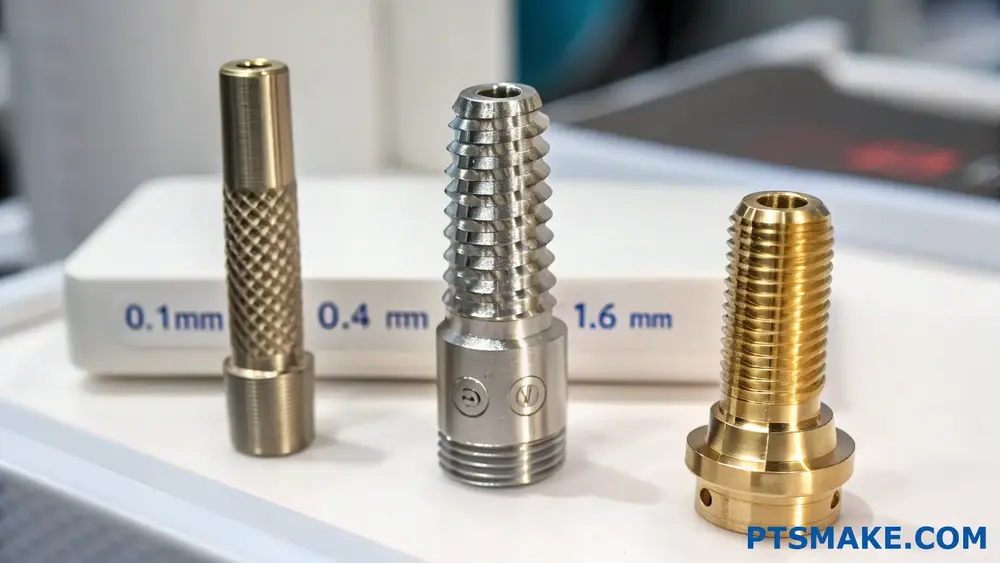
Understanding Surface Finish Measurements in Medical Manufacturing
When discussing medical components, precision isn’t just a preference—it’s a requirement. Surface finish refers to the microscopic texture of a component’s surface, typically measured in micrometers (μm) using the Ra (Roughness Average) scale. In my experience working with medical device manufacturers, I’ve found that understanding these measurements is fundamental to delivering compliant components.
The Ra value represents the arithmetic mean of surface irregularities measured from a mean line. Lower Ra values indicate smoother surfaces. For medical applications, we typically work with Ra values ranging from 0.1 μm (mirror-like finish) to 1.6 μm (smooth but visible machining marks).
Common Surface Finish Measurements for Medical Components
| Finish Type | Ra Value (μm) | Common Applications | Notes |
|---|---|---|---|
| Mirror | 0.1-0.2 | Implantable devices, surgical instruments | Requires specialized polishing |
| Fine | 0.2-0.4 | Fluid pathways, injection components | Standard for components in contact with blood/tissue |
| Medium | 0.4-0.8 | External device housings, fixtures | Balances functionality with manufacturability |
| Standard | 0.8-1.6 | Non-critical external components | Most economical finish for medical parts |
Critical Surface Finish Requirements by Medical Application
Surface finish requirements vary significantly depending on the specific medical application. Working with PTSMAKE’s medical clients has taught me that each component category has unique considerations.
Implantable Devices
Implantable devices like orthopedic implants, pacemaker components, and dental implants require the strictest surface finish standards. These components typically need Ra values between 0.1-0.4 μm. This exceptional smoothness prevents:
- Bacterial colonization and biofilm8 formation
- Tissue irritation or inflammation
- Accelerated corrosion or material degradation
- Premature implant failure
For titanium implants, surface finish directly impacts osseointegration (bone adherence). Interestingly, some implant surfaces are deliberately textured in specific patterns to promote better biological integration.
Surgical Instruments
Surgical instruments must balance functionality with cleanability. Typically, these components require:
- Handle surfaces: 0.4-0.8 μm Ra for comfortable grip
- Functional surfaces (cutting edges, jaws): 0.2-0.4 μm Ra for precise operation
- Hidden surfaces and joints: 0.8-1.6 μm Ra, but must be designed to prevent fluid trapping
Surface finish directly impacts an instrument’s ability to be properly sterilized between uses, making it a critical safety factor.
Fluid Pathway Components
Components that contact bodily fluids, medications, or other solutions require careful surface finish consideration:
- Blood-contacting surfaces: 0.2-0.4 μm Ra to prevent platelet activation
- Medication delivery components: 0.2-0.4 μm Ra to prevent particulate generation
- Fluidic connectors and valves: 0.4-0.8 μm Ra to ensure proper sealing
In these applications, even microscopic surface imperfections can create fluid turbulence, material shedding, or bacterial harborage points.
Surface Finish Achievement Methods for Medical CNC Components
At PTSMAKE, we employ several techniques to achieve the precise surface finishes required for medical components:
CNC Machining Parameters Optimization
The foundation of good surface finish begins with the CNC machining process itself:
- High spindle speeds with low feed rates for finer finishes
- Premium-grade cutting tools with specialized geometries
- Rigid fixturing to eliminate vibration
- Strategic tool path planning to minimize tool marks
- Appropriate coolant application to manage heat generation
Post-Machining Surface Treatments
For most medical applications, machining alone isn’t sufficient to meet surface requirements:
- Mechanical polishing: Using progressively finer abrasives to achieve mirror-like finishes
- Electropolishing: Removing surface material through electrochemical processes
- Micro-blasting: Creating controlled textures for specific functional requirements
- Passivation: Chemical treatment that enhances corrosion resistance and surface properties
- Tumbling/vibratory finishing: Mass finishing for complex geometries
Regulatory Requirements Governing Medical Surface Finishes
Medical component manufacturers must navigate complex regulatory requirements:
- FDA guidelines specify both direct and indirect surface finish requirements
- ISO 13485 quality management systems demand documented surface finish control
- ASTM F86 provides standards for surface preparation of medical implants
- Material-specific standards (like ASTM F1537 for cobalt-chrome alloys) include surface considerations
Documentation of surface finish verification is as important as the finish itself. At PTSMAKE, we maintain detailed records of measurement methods, calibration, and results for traceability.
Common Challenges in Achieving Medical-Grade Surface Finishes
After years in precision manufacturing, I’ve identified several recurring challenges:
- Material-specific issues: Certain titanium alloys and stainless steels require specialized approaches
- Complex geometries: Internal surfaces and intricate features demand creative finishing solutions
- Maintaining dimensional accuracy: Aggressive finishing processes can compromise tight tolerances
- Consistency across production runs: Establishing repeatable processes for surface finish uniformity
- Cost-effective approaches: Balancing the need for premium finishes with economic realities
Future Trends in Medical Component Surface Finishing
The medical device industry continues to evolve, and with it, surface finish requirements:
- Increased adoption of additive manufacturing requiring innovative post-processing
- Advanced surface treatments combining physical and biochemical modifications
- More precise measurement technologies enabling tighter controls
- Biomimetic surfaces designed to interact specifically with human tissues
- Antimicrobial and anti-thrombogenic surface modifications
How To Maintain Sterility Standards In Medical CNC Machining Processes?
Have you ever wondered why medical devices fail despite perfect designs? Or why some manufacturers struggle with FDA rejections? In medical CNC machining, maintaining sterility isn’t just important—it’s critical. One contamination oversight can compromise patient safety and lead to costly recalls.
Maintaining sterility standards in medical CNC machining requires implementing controlled manufacturing environments, proper material handling protocols, regular validation testing, and comprehensive documentation. These practices ensure components meet FDA requirements and ISO 13485 standards while prioritizing patient safety in medical device production.
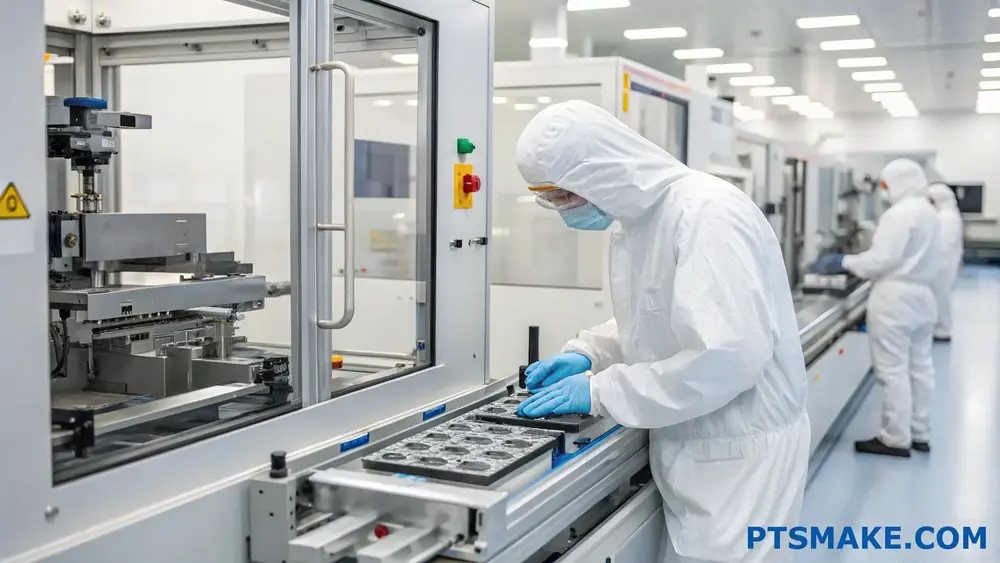
Understanding Sterility Requirements for Medical Components
Medical devices have some of the most stringent requirements across all manufacturing sectors. When machining components that will come into contact with the human body, sterility becomes a non-negotiable aspect of quality control.
Regulatory Framework
The medical device industry operates under strict regulations. The FDA in the United States and similar bodies worldwide mandate specific cleanliness levels for different medical device classifications:
| Device Classification | Contact Level | Sterility Requirements |
|---|---|---|
| Class I | Non-invasive | General cleanliness, low bioburden |
| Class II | External contact | Enhanced cleanliness, low particulate |
| Class III | Implantable/Invasive | Complete sterility, zero bioburden |
These classifications determine the level of sterility validation needed. For example, implantable devices require complete biocompatibility9 testing and absolute sterility assurance.
Cleanroom Classifications
Medical CNC machining often happens in controlled environments classified by ISO 14644-1 standards:
| ISO Class | Maximum Particles/m³ ≥0.5μm | Typical Applications |
|---|---|---|
| ISO 5 (Class 100) | 3,520 | Critical implantables |
| ISO 6 (Class 1,000) | 35,200 | Surgical instruments |
| ISO 7 (Class 10,000) | 352,000 | General medical components |
| ISO 8 (Class 100,000) | 3,520,000 | Non-critical assemblies |
At PTSMAKE, we’ve invested in ISO 7 cleanroom facilities for our medical device manufacturing, ensuring that sensitive components maintain their integrity throughout the machining process.
Essential Sterility Protocols in CNC Operations
Material Handling and Preparation
The sterility chain begins with material selection and handling:
- Validated Suppliers: Source materials from suppliers with medical-grade certifications
- Receipt Inspection: Test incoming materials for contaminants
- Controlled Storage: Store materials in clean, temperature-controlled environments
- Pre-processing Cleaning: Clean raw materials before they enter the machining area
I’ve found that implementing a material tracking system helps maintain this chain of sterility from reception to final product.
Machine Setup and Maintenance
CNC machines used for medical components require special considerations:
- Dedicated Equipment: Designate machines exclusively for medical production
- Filtered Coolants: Use filtered, antimicrobial coolants to prevent contamination
- Regular Sanitization: Clean machines between production runs
- Preventive Maintenance: Schedule regular maintenance to prevent contamination from machine wear
One critical factor I’ve learned is that coolant management is often overlooked but tremendously important. Bacterial growth in coolant systems can introduce biological contamination to otherwise sterile components.
Post-Machining Processes
After machining, components require careful handling:
- Immediate Containment: Transfer parts to clean containers immediately
- Validated Cleaning: Use ultrasonic or other validated cleaning methods
- Inspection in Clean Environments: Perform quality checks in controlled areas
- Sterile Packaging: Package in appropriate medical-grade materials
Validation and Testing Methodologies
Particle Counting and Bioburden Testing
Regular testing verifies sterility maintenance:
- Surface Sampling: Swab part surfaces to detect microorganisms
- Particle Counting: Monitor airborne particles in manufacturing areas
- Bacterial Endotoxin Testing: Check for pyrogens that could cause fever responses
Sterilization Validation
Most medical components undergo final sterilization:
- Gamma Irradiation: Common for implantables and sensitive instruments
- Ethylene Oxide (EtO): Suitable for heat-sensitive components
- Autoclave/Steam: For heat-resistant metal components
The sterilization method must be validated for each specific product, ensuring it effectively eliminates all microbial life without compromising the component’s integrity.
Documentation and Traceability
Comprehensive documentation is essential for regulatory compliance:
- Batch Records: Document all production parameters
- Cleaning Validation: Record all cleaning procedures and verification
- Environmental Monitoring: Log cleanroom conditions
- Material Certificates: Maintain material certifications
- Process Validation: Document proof that processes consistently produce sterile results
At PTSMAKE, we’ve implemented electronic documentation systems that track each component from raw material to finished product, providing complete traceability that our medical device clients require.
Common Challenges and Solutions
Based on my experience working with medical device manufacturers, these are frequent sterility challenges:
Particulate Contamination
Metal and plastic particles can become embedded in components during machining. Solutions include:
- HEPA-filtered air systems: Reduce airborne particles
- Optimized cutting parameters: Minimize burr formation
- Ultrasonic cleaning: Remove embedded particles
Human Factors
Operators can inadvertently introduce contamination. Mitigations include:
- Comprehensive training: Educate staff on sterility protocols
- Proper gowning procedures: Implement cleanroom gowning
- Limited access: Restrict cleanroom access to essential personnel
Through proper planning and strict adherence to protocols, these challenges can be effectively managed to ensure consistent sterility standards.
What Supply Chain Considerations Are Critical For Medical CNC Machining Partnerships?
Have you ever faced unexpected delays with your medical device components? Or discovered non-compliant materials in your supply chain too late in production? In medical manufacturing, these supply chain failures aren’t just frustrating—they can literally put patient lives at risk.
Medical CNC machining partnerships require rigorous supply chain considerations including material traceability, regulatory compliance, risk mitigation strategies, and transparent communication protocols. Successful medical supply chains balance quality, cost, and delivery while maintaining comprehensive documentation throughout the entire process.
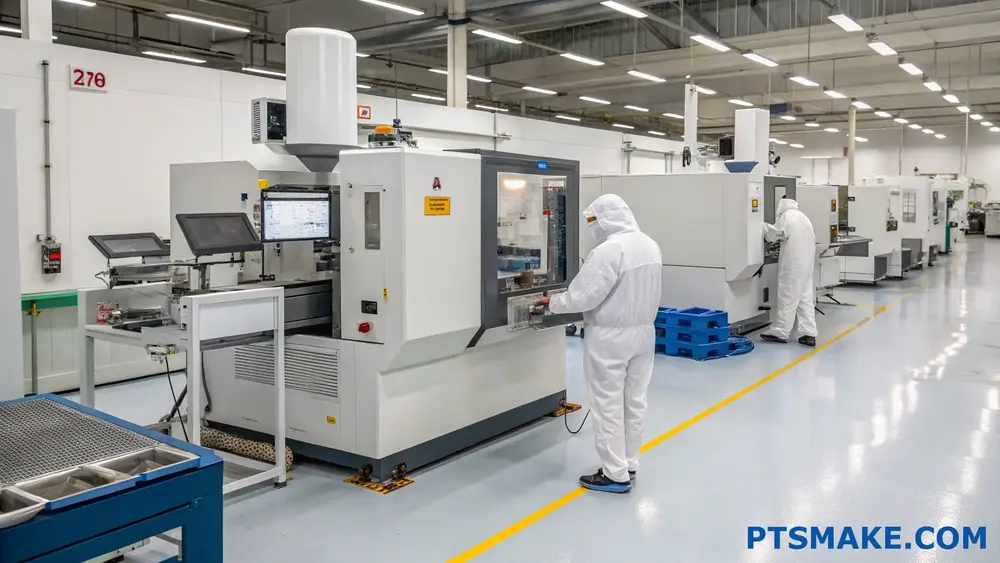
The Foundation: Material Traceability Systems
In my experience working with medical device manufacturers, material traceability stands as perhaps the single most critical supply chain consideration. Medical CNC machining requires absolute certainty about material origins and handling throughout the entire supply chain.
At PTSMAKE, we’ve implemented a comprehensive material traceability system10 that tracks every component from raw material sourcing to finished product delivery. This system ensures that:
- Every batch of material has unique identification
- Material certificates accompany all medical-grade materials
- Complete manufacturing history is documented for each component
- Any material changes require formal approval processes
Material traceability isn’t merely a regulatory checkbox—it’s fundamental protection for patients and manufacturers alike. When a medical device manufacturer can quickly trace components to specific material lots, they can efficiently manage potential recalls and minimize patient risk.
Regulatory Compliance Across Borders
The medical device industry operates under strict regulatory frameworks that vary by region. Your CNC machining partner must demonstrate compliance with:
FDA Requirements (US Market)
- 21 CFR Part 820 Quality System Regulation
- Material biocompatibility documentation
- Design history files when applicable
EU MDR Considerations
- Technical documentation requirements
- Risk management documentation
- Post-market surveillance capabilities
ISO 13485 Certification
Most reputable medical CNC machining partners maintain ISO 13485 certification, which specifically addresses quality management systems for medical devices. This certification ensures systematic approaches to:
- Process validation
- Risk management
- Controlled manufacturing environments
- Document control
When evaluating potential partners, I recommend creating a compliance checklist specific to your target markets. This proactive approach prevents costly regulatory surprises later in your product lifecycle.
Risk Mitigation Strategies
Medical device supply chains face unique vulnerabilities that require specialized risk management. The most effective partnerships implement:
Dual-Sourcing Approaches
Critical materials and components should have alternative supply options to prevent single-point failures. At PTSMAKE, we maintain relationships with multiple certified material suppliers to ensure continuity.
Component Obsolescence Management
Medical devices often have lifecycles spanning decades, requiring proactive management of potential component obsolescence. Your machining partner should have processes to:
- Monitor material availability trends
- Provide advance notification of potential discontinuations
- Develop contingency plans for critical components
Disaster Recovery Planning
Medical device manufacturers cannot afford extended production interruptions. Effective partnerships include robust disaster recovery plans with:
| Recovery Element | Description | Implementation |
|---|---|---|
| Backup Production | Alternative manufacturing capabilities | Secondary production facilities with equivalent capabilities |
| Data Redundancy | Protection of critical manufacturing data | Cloud-based documentation with regular backups |
| Supply Chain Mapping | Understanding of all supply chain dependencies | Regular analysis of supplier network vulnerabilities |
| Communication Protocols | Clear lines of communication during disruptions | Designated points of contact and escalation procedures |
These risk mitigation strategies must balance cost considerations with the absolute requirement for supply continuity in medical applications.
Inventory Management and Just-in-Time Manufacturing
The cost pressures facing medical device manufacturers have driven increasing adoption of lean manufacturing principles. However, medical supply chains require special considerations when implementing just-in-time approaches:
Safety Stock Calculations
Unlike consumer products, medical components often require specialized safety stock models that account for:
- Validation requirements for new production runs
- Extended lead times for specialized materials
- Regulatory approval timelines for changes
Demand Forecasting Challenges
Medical device demand can be particularly difficult to forecast due to:
- Reimbursement policy changes
- Clinical adoption curves
- Regulatory approval timelines
The most successful partnerships I’ve observed combine lean principles with medical-specific inventory management strategies. This balanced approach minimizes carrying costs while ensuring supply continuity for critical components.
Quality Systems Integration
Quality cannot be inspected into a product—it must be built into every process. Medical CNC machining partnerships require seamless integration between manufacturer and supplier quality systems:
Shared Quality Metrics
Establish common quality metrics that align with medical device requirements:
- First-pass yield rates
- Process capability indices (Cpk)
- Defect categorization systems
- Deviation management protocols
Joint CAPA Systems
Corrective and Preventive Action systems should integrate across supply chain partners to enable:
- Root cause analysis across organizational boundaries
- Shared learning from quality events
- Coordinated implementation of corrective actions
During my 15+ years in precision manufacturing, I’ve found that early and continuous quality system integration prevents the fragmentation that often leads to quality escapes in complex medical supply chains.
Communication and Documentation Requirements
Medical device manufacturing requires exceptional documentation and communication standards. The most effective partnerships establish:
Document Control Systems
All manufacturing documentation should be:
- Version-controlled
- Accessible to authorized personnel
- Protected from unauthorized changes
- Regularly reviewed for accuracy
Change Management Protocols
Any changes to specifications, processes, or materials must follow formal protocols including:
- Impact assessments
- Validation requirements
- Customer notification procedures
- Regulatory considerations
Regular Business Reviews
Scheduled reviews should examine:
- Quality performance trends
- Delivery metrics
- Cost management initiatives
- Continuous improvement activities
Clear communication protocols prevent the misalignment that frequently disrupts medical device supply chains. At PTSMAKE, we’ve found that transparent communication about challenges—before they become problems—builds the trust necessary for successful long-term partnerships.
Financial Stability Considerations
The medical device industry operates on extended timelines, making supplier financial stability a critical consideration. When evaluating potential CNC machining partners, assess:
- Business longevity and track record
- Financial stability indicators
- Capital investment patterns
- Industry-specific experience
Your medical device supply chain is only as strong as its most vulnerable link. Ensuring your CNC machining partner has the financial foundation to support your products throughout their lifecycle provides essential protection against disruption.
Click to learn how achieving these tolerances can improve your medical device performance and reliability. ↩
Learn about biocompatibility standards crucial for medical device approval. ↩
Learn about current Good Manufacturing Practice requirements and how they affect your device production. ↩
Learn how GMP compliance affects medical device quality and regulatory approval. ↩
Learn how these errors impact medical device precision and patient safety. ↩
Learn how to calculate optimal production volumes for maximum savings. ↩
Click to learn advanced machining techniques for medical devices ↩
Click for an expert guide on preventing biofilm formation in medical devices. ↩
Learn about material compatibility with human tissue for medical applications. ↩
A comprehensive system that provides complete visibility of materials throughout production, ensuring compliance and patient safety. ↩


